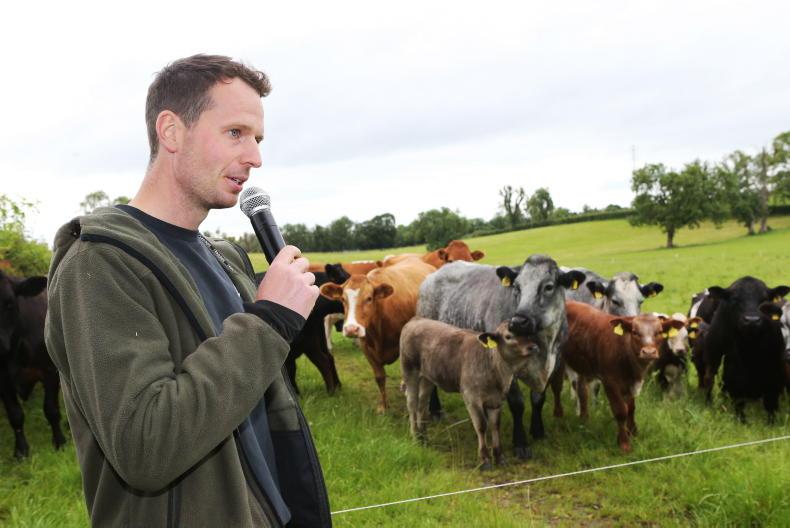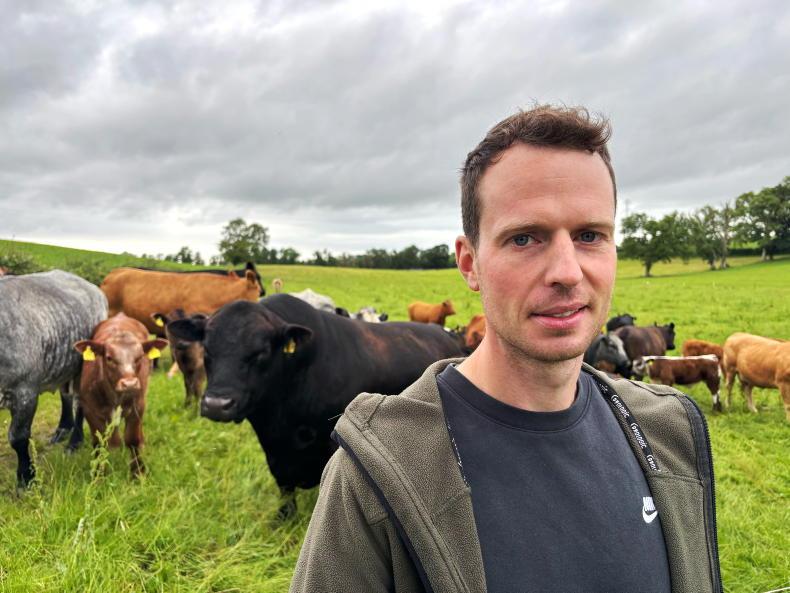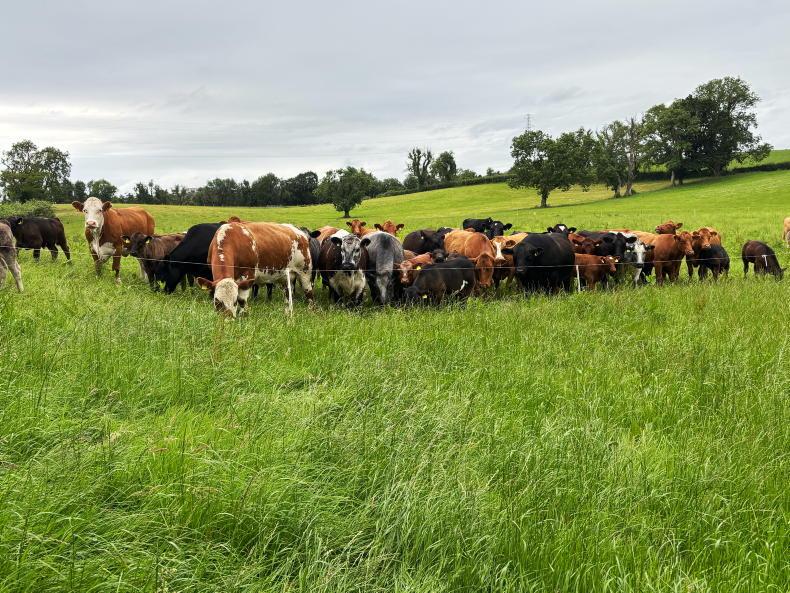Farm facts
Farm size: 280ac of grass along with 60ac of mature woodland.System: spring-calving suckler cow herd to beef, with dairy beef enterprise. Cow numbers: 100Breeds used: stabiliser and
Simmental bulls.The Ulster Grassland Society held its annual summer beef meeting at Lisgoole Abbey Estate Farm located just outside Enniskillen in Co Fermanagh. The farm is a lot larger than a typical Fermanagh farm, but very typical of the land type in the border region: low-lying in parts and hills in other parts.
This area of the country also gets its fair share of rain, with annual rainfall coming in at 1,143mm. This creates challenges in terms of early turnout and also brings a drain maintenance cost to the farm on an annual basis.
The farm has two full-time staff and is home to 100 suckler cows, together with a recent new dairy-beef enterprise to run alongside the sucklers. Conor Donaldson is the farm manager at Lisgoole Abbey and he’s a man who wants to put his own stamp on things. He is currently in his fifth year of managing the farm and still in the process of changing things around. The previous system employed on the farm was very different to where it is today with a heavy, muscled Belgian Blue-type cow being used.
Conor was quick to point out on the farm walk that the system was working, but that he had different objectives for the farm when he came in.
“I wanted to get a work-life balance if I could, and it’s also important to me to get some enjoyment out of what I do and this led me down the Stabiliser route,” he said.

Conor Donaldson is farm manager at Lisgoole Abbey Estate Farm.
Stabilisers
Stabiliser cattle are a composite breed made up of 25% Hereford, Aberdeen Angus, Simmental and Gelbvieh with the Hereford breed being replaced by South Devon cattle in recent years. This gives them the predominantly red or black appearance.
The breed was developed by the Leachman family in Montana in the 1970s and the breed has gained in popularity since with a number of Irish farmers now using Stabiliser bulls to transition to full Stabiliser herds.
Conor feels that the Stabiliser breed ticks a lot of boxes for what he wants to do at Lisgoole Abbey. “We want to select and breed cows with easy-calving traits to reduce labour inputs, stress and veterinary interventions,” he said.
“The cow that was here before was over 850kg, and I felt she just didn’t suit Fermanagh land. They also required a lot of veterinary intervention at calving time and I wanted to get away from that.”
Conor also wanted to increase the liveweight output and carcase output from the herd and this drove him down the bull beef route. All male progeny from the herd are finished as bulls at 15 months averaging 400kg carcase weight.

Lisgoole Abbey Estate Farm is is now using Stabiliser bulls.
Grassland management
Despite the heavy nature of the soil and the high rainfall, Conor places a big emphasis on grassland management and trying to lengthen the grazing season as much as possible.
Moving to a lighter cow and introducing a dairy-beef enterprise has been part of this plan. The lighter Stabiliser-cross cow should be easier to graze and the dairy-beef weanlings have been able to stay out longer in the back end of the year to better utilise autumn grass.
During the main grazing season, large grazing fields are divided up with electric fencing. Some multispecies swards have also been introduced to see if the farm can cut down on its fertiliser application.
The farm doesn’t have a very high stocking rate at 1.6 cow equivalents/ha. Stock are generally turned out in mid-April with weather determining housing dates in the back end of the year.
Cows are generally housed at the end of September with youngstock housed by the end of October. First-cut silage is generally cut in late May/early June with surplus grass baled up for dry cow feeding during the summer months.

All male progeny from the herd are finished as bulls at 15 months, averaging a 400kg carcase weight.
Health management
Cows are vaccinated for BVD and they also receive an annual scour vaccine. Calves are vaccinated against blackleg and pneumonia. Calves also get Vecoxan at turnout. All cows and heifers receive a high-iodine bolus six weeks out from calving.
Beef and breeding heifers also receive a cattle mineral bolus at turnout. High-magnesium licks are also offered to cows during the grazing season. In 2025, 96% of the herd calved in 12 weeks with 100 live calves on the ground from 100 cows, so Conor feels the system is working.
“The Stabiliser calf’s willingness to get up and suck straight away is unreal and that takes a lot of work out of it for us,” he said.

Conor Donaldson is passionate about breeding and what it can do for Lisgoole.
Breeding
Conor is passionate about breeding and what it can do for the farm. He feels changing cow type has brought positive changes to the farm. The Stabiliser mix is working, but he isn’t happy to leave it there. He has started to toy with the idea of introducing some artificial insemination (AI) into the herd and has trialled a synchronisation programme on the farm to try and make it easier to increase AI usage.
He feels he would like to keep a little continental mix in the cow especially when it comes to finishing his heifers.
“We are looking for a cow to have good temperament, sound feet and a proven ability to consistently wean a heavy calf. We don’t want big cows, but we don’t want very small ones either,” Conor said.
Weaning weights on the farm are currently coming in at 365kg for the bull calves and 325kg for the heifer calves. Heifers are all bred to calve at two years of age with the current batch of heifers with the bull averaging 420kg in the middle of June.
Stabiliser bulls have the capability to achieve big weight gains with the current batch of bulls on ad-lib concentrate feeding averaging 1.7kg of liveweight gain per day.
“The kill out of the Stabiliser bull is a little lower than continentals, but it’s a lot easier to get fat cover on them,” Conor said.

Moving to a lighter cow and introducing a dairy-beef enterprise has been a part of Lisgoole's plan to improve grassland management..

Farm facts
Farm size: 280ac of grass along with 60ac of mature woodland.System: spring-calving suckler cow herd to beef, with dairy beef enterprise. Cow numbers: 100Breeds used: stabiliser and
Simmental bulls.The Ulster Grassland Society held its annual summer beef meeting at Lisgoole Abbey Estate Farm located just outside Enniskillen in Co Fermanagh. The farm is a lot larger than a typical Fermanagh farm, but very typical of the land type in the border region: low-lying in parts and hills in other parts.
This area of the country also gets its fair share of rain, with annual rainfall coming in at 1,143mm. This creates challenges in terms of early turnout and also brings a drain maintenance cost to the farm on an annual basis.
The farm has two full-time staff and is home to 100 suckler cows, together with a recent new dairy-beef enterprise to run alongside the sucklers. Conor Donaldson is the farm manager at Lisgoole Abbey and he’s a man who wants to put his own stamp on things. He is currently in his fifth year of managing the farm and still in the process of changing things around. The previous system employed on the farm was very different to where it is today with a heavy, muscled Belgian Blue-type cow being used.
Conor was quick to point out on the farm walk that the system was working, but that he had different objectives for the farm when he came in.
“I wanted to get a work-life balance if I could, and it’s also important to me to get some enjoyment out of what I do and this led me down the Stabiliser route,” he said.

Conor Donaldson is farm manager at Lisgoole Abbey Estate Farm.
Stabilisers
Stabiliser cattle are a composite breed made up of 25% Hereford, Aberdeen Angus, Simmental and Gelbvieh with the Hereford breed being replaced by South Devon cattle in recent years. This gives them the predominantly red or black appearance.
The breed was developed by the Leachman family in Montana in the 1970s and the breed has gained in popularity since with a number of Irish farmers now using Stabiliser bulls to transition to full Stabiliser herds.
Conor feels that the Stabiliser breed ticks a lot of boxes for what he wants to do at Lisgoole Abbey. “We want to select and breed cows with easy-calving traits to reduce labour inputs, stress and veterinary interventions,” he said.
“The cow that was here before was over 850kg, and I felt she just didn’t suit Fermanagh land. They also required a lot of veterinary intervention at calving time and I wanted to get away from that.”
Conor also wanted to increase the liveweight output and carcase output from the herd and this drove him down the bull beef route. All male progeny from the herd are finished as bulls at 15 months averaging 400kg carcase weight.

Lisgoole Abbey Estate Farm is is now using Stabiliser bulls.
Grassland management
Despite the heavy nature of the soil and the high rainfall, Conor places a big emphasis on grassland management and trying to lengthen the grazing season as much as possible.
Moving to a lighter cow and introducing a dairy-beef enterprise has been part of this plan. The lighter Stabiliser-cross cow should be easier to graze and the dairy-beef weanlings have been able to stay out longer in the back end of the year to better utilise autumn grass.
During the main grazing season, large grazing fields are divided up with electric fencing. Some multispecies swards have also been introduced to see if the farm can cut down on its fertiliser application.
The farm doesn’t have a very high stocking rate at 1.6 cow equivalents/ha. Stock are generally turned out in mid-April with weather determining housing dates in the back end of the year.
Cows are generally housed at the end of September with youngstock housed by the end of October. First-cut silage is generally cut in late May/early June with surplus grass baled up for dry cow feeding during the summer months.

All male progeny from the herd are finished as bulls at 15 months, averaging a 400kg carcase weight.
Health management
Cows are vaccinated for BVD and they also receive an annual scour vaccine. Calves are vaccinated against blackleg and pneumonia. Calves also get Vecoxan at turnout. All cows and heifers receive a high-iodine bolus six weeks out from calving.
Beef and breeding heifers also receive a cattle mineral bolus at turnout. High-magnesium licks are also offered to cows during the grazing season. In 2025, 96% of the herd calved in 12 weeks with 100 live calves on the ground from 100 cows, so Conor feels the system is working.
“The Stabiliser calf’s willingness to get up and suck straight away is unreal and that takes a lot of work out of it for us,” he said.

Conor Donaldson is passionate about breeding and what it can do for Lisgoole.
Breeding
Conor is passionate about breeding and what it can do for the farm. He feels changing cow type has brought positive changes to the farm. The Stabiliser mix is working, but he isn’t happy to leave it there. He has started to toy with the idea of introducing some artificial insemination (AI) into the herd and has trialled a synchronisation programme on the farm to try and make it easier to increase AI usage.
He feels he would like to keep a little continental mix in the cow especially when it comes to finishing his heifers.
“We are looking for a cow to have good temperament, sound feet and a proven ability to consistently wean a heavy calf. We don’t want big cows, but we don’t want very small ones either,” Conor said.
Weaning weights on the farm are currently coming in at 365kg for the bull calves and 325kg for the heifer calves. Heifers are all bred to calve at two years of age with the current batch of heifers with the bull averaging 420kg in the middle of June.
Stabiliser bulls have the capability to achieve big weight gains with the current batch of bulls on ad-lib concentrate feeding averaging 1.7kg of liveweight gain per day.
“The kill out of the Stabiliser bull is a little lower than continentals, but it’s a lot easier to get fat cover on them,” Conor said.

Moving to a lighter cow and introducing a dairy-beef enterprise has been a part of Lisgoole's plan to improve grassland management..













 This is a subscriber-only article
This is a subscriber-only article










SHARING OPTIONS: